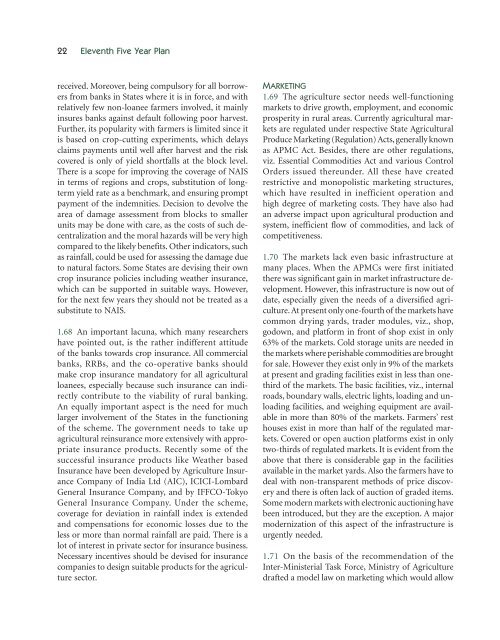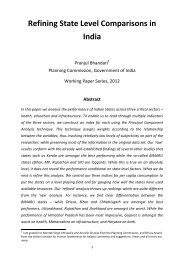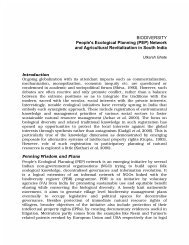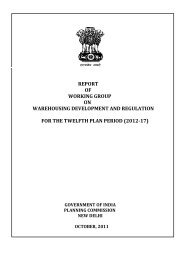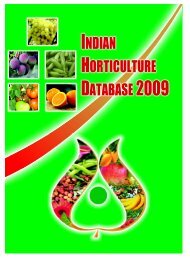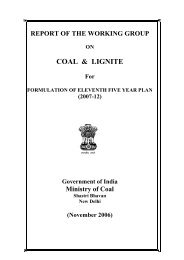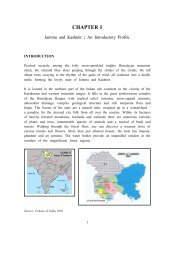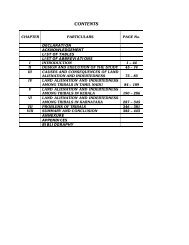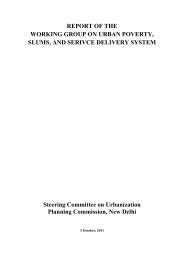Eleventh Five Year Plan - of Planning Commission
Eleventh Five Year Plan - of Planning Commission
Eleventh Five Year Plan - of Planning Commission
Create successful ePaper yourself
Turn your PDF publications into a flip-book with our unique Google optimized e-Paper software.
22 <strong>Eleventh</strong> <strong>Five</strong> <strong>Year</strong> <strong>Plan</strong><br />
received. Moreover, being compulsory for all borrowers<br />
from banks in States where it is in force, and with<br />
relatively few non-loanee farmers involved, it mainly<br />
insures banks against default following poor harvest.<br />
Further, its popularity with farmers is limited since it<br />
is based on crop-cutting experiments, which delays<br />
claims payments until well after harvest and the risk<br />
covered is only <strong>of</strong> yield shortfalls at the block level.<br />
There is a scope for improving the coverage <strong>of</strong> NAIS<br />
in terms <strong>of</strong> regions and crops, substitution <strong>of</strong> longterm<br />
yield rate as a benchmark, and ensuring prompt<br />
payment <strong>of</strong> the indemnities. Decision to devolve the<br />
area <strong>of</strong> damage assessment from blocks to smaller<br />
units may be done with care, as the costs <strong>of</strong> such decentralization<br />
and the moral hazards will be very high<br />
compared to the likely benefits. Other indicators, such<br />
as rainfall, could be used for assessing the damage due<br />
to natural factors. Some States are devising their own<br />
crop insurance policies including weather insurance,<br />
which can be supported in suitable ways. However,<br />
for the next few years they should not be treated as a<br />
substitute to NAIS.<br />
1.68 An important lacuna, which many researchers<br />
have pointed out, is the rather indifferent attitude<br />
<strong>of</strong> the banks towards crop insurance. All commercial<br />
banks, RRBs, and the co-operative banks should<br />
make crop insurance mandatory for all agricultural<br />
loanees, especially because such insurance can indirectly<br />
contribute to the viability <strong>of</strong> rural banking.<br />
An equally important aspect is the need for much<br />
larger involvement <strong>of</strong> the States in the functioning<br />
<strong>of</strong> the scheme. The government needs to take up<br />
agricultural reinsurance more extensively with appropriate<br />
insurance products. Recently some <strong>of</strong> the<br />
successful insurance products like Weather based<br />
Insurance have been developed by Agriculture Insurance<br />
Company <strong>of</strong> India Ltd (AIC), ICICI-Lombard<br />
General Insurance Company, and by IFFCO-Tokyo<br />
General Insurance Company. Under the scheme,<br />
coverage for deviation in rainfall index is extended<br />
and compensations for economic losses due to the<br />
less or more than normal rainfall are paid. There is a<br />
lot <strong>of</strong> interest in private sector for insurance business.<br />
Necessary incentives should be devised for insurance<br />
companies to design suitable products for the agriculture<br />
sector.<br />
MARKETING<br />
1.69 The agriculture sector needs well-functioning<br />
markets to drive growth, employment, and economic<br />
prosperity in rural areas. Currently agricultural markets<br />
are regulated under respective State Agricultural<br />
Produce Marketing (Regulation) Acts, generally known<br />
as APMC Act. Besides, there are other regulations,<br />
viz. Essential Commodities Act and various Control<br />
Orders issued thereunder. All these have created<br />
restrictive and monopolistic marketing structures,<br />
which have resulted in inefficient operation and<br />
high degree <strong>of</strong> marketing costs. They have also had<br />
an adverse impact upon agricultural production and<br />
system, inefficient flow <strong>of</strong> commodities, and lack <strong>of</strong><br />
competitiveness.<br />
1.70 The markets lack even basic infrastructure at<br />
many places. When the APMCs were first initiated<br />
there was significant gain in market infrastructure development.<br />
However, this infrastructure is now out <strong>of</strong><br />
date, especially given the needs <strong>of</strong> a diversified agriculture.<br />
At present only one-fourth <strong>of</strong> the markets have<br />
common drying yards, trader modules, viz., shop,<br />
godown, and platform in front <strong>of</strong> shop exist in only<br />
63% <strong>of</strong> the markets. Cold storage units are needed in<br />
the markets where perishable commodities are brought<br />
for sale. However they exist only in 9% <strong>of</strong> the markets<br />
at present and grading facilities exist in less than onethird<br />
<strong>of</strong> the markets. The basic facilities, viz., internal<br />
roads, boundary walls, electric lights, loading and unloading<br />
facilities, and weighing equipment are available<br />
in more than 80% <strong>of</strong> the markets. Farmers’ rest<br />
houses exist in more than half <strong>of</strong> the regulated markets.<br />
Covered or open auction platforms exist in only<br />
two-thirds <strong>of</strong> regulated markets. It is evident from the<br />
above that there is considerable gap in the facilities<br />
available in the market yards. Also the farmers have to<br />
deal with non-transparent methods <strong>of</strong> price discovery<br />
and there is <strong>of</strong>ten lack <strong>of</strong> auction <strong>of</strong> graded items.<br />
Some modern markets with electronic auctioning have<br />
been introduced, but they are the exception. A major<br />
modernization <strong>of</strong> this aspect <strong>of</strong> the infrastructure is<br />
urgently needed.<br />
1.71 On the basis <strong>of</strong> the recommendation <strong>of</strong> the<br />
Inter-Ministerial Task Force, Ministry <strong>of</strong> Agriculture<br />
drafted a model law on marketing which would allow


